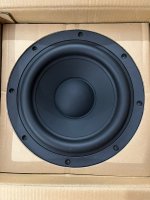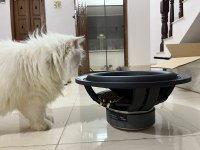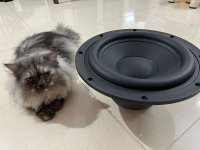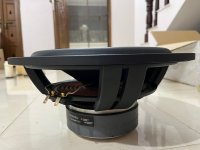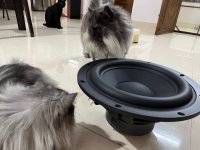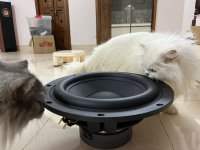Hello,
Could someone help me to understand Group delay when it comes to Subwoofers?
What would be a good number to aim for in Micro Seconds for 23 HZ tuning?
The subwoofer driver I am using is SB34SWPL76-4 and its EBP is 55.9.
I have modelled a vented enclosure in WinISD for this Sub and am getting a group delay of 30 MS at 23 HZ. The subwoofer enclosure will have a volume of 60 litres.
Could someone help me to understand Group delay when it comes to Subwoofers?
What would be a good number to aim for in Micro Seconds for 23 HZ tuning?
The subwoofer driver I am using is SB34SWPL76-4 and its EBP is 55.9.
I have modelled a vented enclosure in WinISD for this Sub and am getting a group delay of 30 MS at 23 HZ. The subwoofer enclosure will have a volume of 60 litres.
Attachments
Group delay is the inevitable outcome of the phase response of a linear time invariant system. GD is just another representation the system's phase response. The phase response is determined by the frequency response of the system and any filters applied to it (crossover filters). Essentially the phase response at any given frequency is a weighted sum of derivatives of the frequency response around that frequency, with less weight given for more distant frequencies (Bode's Relationship). The steeper the response falls off the higher the derivative and the higher the group delay.
Typically the group delay (without filters) magnitude can climb to as much as 50msec at low frequencies. Don't worry about it. You are not really sensitive to GD below 100Hz, and even 50msec is only 1 cycle at 20Hz. At higher frequencies 1 cycle worth of GD is around the threshold of audibility, roughly speaking, with the threshold falling to around 1-1.5 msec by 1kHz and more or less remaining at that level for frequencies above about 2kHz.
Typically the group delay (without filters) magnitude can climb to as much as 50msec at low frequencies. Don't worry about it. You are not really sensitive to GD below 100Hz, and even 50msec is only 1 cycle at 20Hz. At higher frequencies 1 cycle worth of GD is around the threshold of audibility, roughly speaking, with the threshold falling to around 1-1.5 msec by 1kHz and more or less remaining at that level for frequencies above about 2kHz.
Thank you @CharlieLaub. Really appreciate your help on this question. I will go ahead with the design and share the once it is done.
Micro seconds (μs) are one millionth (1⁄1000000) of a second, one thousand times shorter than a millisecond (ms), which is one thousandth (1/1000) of a second.What would be a good number to aim for in Micro Seconds for 23 HZ tuning?
I have modelled a vented enclosure in WinISD for this Sub and am getting a group delay of 30 MS at 23 HZ.
Note that, of the various vented box alignments that can be used, the QB3 alignment has a quite good transient response. It's a bit better damped than a B4 alignment, which would need a driver with a somewhat higher Qts value. However, the required box volume is smaller, and the cut-off frequency will be a bit higher.The subwoofer driver I am using is SB34SWPL76-4 and its EBP is 55.9. I have modelled a vented enclosure in WinISD for this Sub and am getting a group delay of 30 ms at 23 Hz. The subwoofer enclosure will have a volume of 60 litres.
With a 60-litre enclosure and a vent tuning frequency of 23 Hz, WinISD produces the following response:
I expect that the slight peak in the response at about 28 Hz will be reduced a little bit by port and enclosure losses.
Reducing the box volume to 50 litres and the vent tuning frequency to 22.5 Hz produces the response below. This has a shallow shelf before the roll-off starts, and it will be a slightly more damped response, especially without the presence of a peak. It may be worth considering as an alternative.
wont port noise become a issue at loud volumes?

at max power (300 watts) the air velocity is above 40m/s while at 17m/s you can already experience port noise
with 48 watts you will hit the 17m/s mark
The port in this simulation is 45cm long and 8,4cm in diameter
good thing is you wont hit your xmax if you dont play below 20hz but i would still recommend a high pass filter at 20-22hz to protect from the lower notes
I have a self made subwoofer at home with 50ms group delay and i have 0 problems with it exept the port noise (which has nothing to do with the group delay) how i see it your port noise will occur at 3db louder then mine (mine makes port noise at really low volume levels could be because of a flare thats too small)
at max power (300 watts) the air velocity is above 40m/s while at 17m/s you can already experience port noise
with 48 watts you will hit the 17m/s mark
The port in this simulation is 45cm long and 8,4cm in diameter
good thing is you wont hit your xmax if you dont play below 20hz but i would still recommend a high pass filter at 20-22hz to protect from the lower notes
I have a self made subwoofer at home with 50ms group delay and i have 0 problems with it exept the port noise (which has nothing to do with the group delay) how i see it your port noise will occur at 3db louder then mine (mine makes port noise at really low volume levels could be because of a flare thats too small)
Sorry, didn't notice when I was posting.Micro seconds (μs) are one millionth (1⁄1000000) of a second, one thousand times shorter than a millisecond (ms), which is one thousandth (1/1000) of a second.
Thank you for taking the time to share the details. I am also planning to go with 50 litres and 23 HZ as the final volume for the vented enclosure. I will be using Baltic birch plywood for the enclosure and there is enough space available to build a sealed version of the subwoofer also.Note that, of the various vented box alignments that can be used, the QB3 alignment has a quite good transient response. It's a bit better damped than a B4 alignment, which would need a driver with a somewhat higher Qts value. However, the required box volume is smaller, and the cut-off frequency will be a bit higher.
With a 60-litre enclosure and a vent tuning frequency of 23 Hz, WinISD produces the following response:
View attachment 1149195
I expect that the slight peak in the response at about 28 Hz will be reduced a little bit by port and enclosure losses.
Reducing the box volume to 50 litres and the vent tuning frequency to 22.5 Hz produces the response below. This has a shallow shelf before the roll-off starts, and it will be a slightly more damped response, especially without the presence of a peak. It may be worth considering as an alternative.
View attachment 1149192
The final plan is to get 2 Subwoofers and I will decide which one to settle on after testing both vented and sealed. Suggested sealed volume in Win ISD is 22.71.
Sharing some images of the driver.
Attachments
Thank you for taking the time to share the details.wont port noise become a issue at loud volumes?
View attachment 1149223
at max power (300 watts) the air velocity is above 40m/s while at 17m/s you can already experience port noise
with 48 watts you will hit the 17m/s mark
The port in this simulation is 45cm long and 8,4cm in diameter
good thing is you wont hit your xmax if you dont play below 20hz but i would still recommend a high pass filter at 20-22hz to protect from the lower notes
I have a self made subwoofer at home with 50ms group delay and i have 0 problems with it exept the port noise (which has nothing to do with the group delay) how i see it your port noise will occur at 3db louder then mine (mine makes port noise at really low volume levels could be because of a flare thats too small)
I am planning to use a 4 Inch (10.10 CM) diameter port and the port length is 33.18 Inches (84.39 CM) Hopefully flared port will reduce port noise at listening levels. The final design will have 2 subwoofers so I won't be driving them very loud.
Attachments
I hope you post your results as you build. Interested in a few “small” 12” subwoofers to make an array around my home theatre. These guys seem super economical and surprisingly good output for their cost and enclosure size.
Watching with interest!
Watching with interest!
- Home
- Loudspeakers
- Subwoofers
- What would be an acceptable group delay for a 12-inch vented subwoofer?
